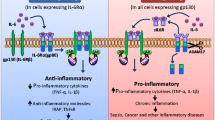Abstract
This study was conducted to investigate the role of tumor necrosis factor-α (TNF-α) and interleukin-2 (IL-2) in inducing cancer cachexia, and the results were compared with those obtained from our previous study on Fisher 344 rats with methylcholanthrene-induced sarcoma. Three groups of male Fisher 344 rats received one of the following regimens: 4×104 IU of human recombinant TNF-α per rat per day subcutaneously (sc) for 5 consecutive days (n=5), 3.5×105 U human recombinant IL-2 per rat per day sc for 14 consecutive days (n=5), or normal saline (n=5). The activities of both phosphoenolpyruvate carboxykinase (PEPCK) and malic enzyme (ME) were increased slightly in the IL-2 group. Furthermore, LPL activity was significantly increased in the adipose tissue of the TNF group and in the cardiac muscle of the IL-2 group, but not in that of the TNF group. These results show that there is a significant difference between the metabolic alterations seen in the tumor-bearing state and those induced by either TNF-α or IL-2 alone. Thus, it is unlikely that IL-2 or TNF-α is the sole mediator of cancer cachexia in this tumor and rat model.
Similar content being viewed by others
References
Kawakami M, Cerami A (1981) Studies of endotoxin-induced decrease in lipoprotein lipase activity. J Exp Med 154:631–637
Beutler B, Cerami A (1986) Cachectin and tumor necrosis factor as two sides of the same biological coin. Nature 320:584–588
Greenberg AS, Nordan RP, McIntosh J, Cvalvo JC, Scow RD, Joblons D (1992) Interleukin-6 reduces lipoprotein lipase activity in adipose tissue in vivo and in 3T3-L1 adipocytes: a possible role for interleukin-6 in cancer cachexia. Cancer Res 52:4113–4116
Noguchi Y, Vydelingum NA, Brennan MF (1989) The reversal of increased gluconeogenesis in the tumor-bearing rat by tumor removal and food intake. Surgery 106:423–431
Younes RN, Vydelingum NA, Noguchi Y, Brennan MF (1990) Lipid kinetic alterations in tumor-bearing rats: reversal by tumor excision. J Surg Res 48:324–328
Noguchi Y, Vydelingum NA, Yopunes RN, Fried SK, Brennan MF (1991) Tumor-induced alterations in tissue lipoprotein lipase activity and mRNA levels. Cancer Res 51:863–869
Noguchi Y, Vydelingum NA, Brennan MF (1993) Evidence for tumor-induced alterations in hepatic lipogenesis and fatty acid oxidation. J Surg Res 55:357–363
Bucolo G, David H (1972) Quantitative determination of serum triglyceride by the use of enzymes. Clin Chem 19:476–482
Chang HC, Lane MD (1966) The enzymatic carboxylation of phosphoenolpyruvate: II. Purification and properties of liver mitochondrial phosphoenolpyruvate carboxykinase. J Biol Chem 241:2413–2420
Hsu RY, Lardy HA (1969) Malic enzyme. Methods Enzymol 13:230–235
Bradford MA (1976) A rapid and sensitive method for the quantitation of microgram quantities of protein utilizing the principles of protein-dye binding. Anal Biochem 72:248–254
Nilsson-Ehle P, Garfunkel AS, Schotz MC (1980) Lipolytic enzyme and plasma lipoprotein lipase metabolism. Ann Rev Biochem 49:668–63
Moldawer LL, Andersson C, Gelin J, Lundholm KG (1988) Regulation of food intake and hepatic protein synthesis by recombinant-derived cytokines. Am J Physiol 254:450–456
Norton JA (1991) Mechanisms of cancer cachexia. Hematol Oncol Clin North Am 103–123
Carswell EA, Old LJ, Kassel RL, Green S, Fiore N, Williamson B (1975) An endotoxin-induced serum factor that causes necrosis of tumours. Proc Natl Acad Sci USA 72:3666–3670
Oliff A (1988) The role of tumor necrosis factor (cachectin) in cachexia. Cell 54:141–142
Mahony SM, Tisdale MJ (1989) Role of prostaglandins in tumor necrosis factor-induced weight loss. Br J Cancer 60:51–55
Michie HR, Sherman ML, Spriggs DR, Christie RJ, Wilmore DW (1989) Chronic TNF infusion causes anemia and not accelerated nitrogen loss. Ann Surg 104:280–286
Darling G, Fraker DL, Jensen JC, Gorschboth CM, Northon JA (1990) Cachectic effects of recombinant tumor necrosis factor in rats. Cancer Res 50:4008–4013
Mahony SM, Tisdale MJ (1988) Induction of weight loss and metabolic alterations by human recombinant tumor necrosis factor. Br J Cancer 58:345–349
Feingold KR, Grunfeld C (1987) Tumor necrosis factor-alpha stimulates hepatic lipogenesis in the rat liver in vitro. J Clin Invest 80:184–190
Textor SC, Margolin K, Blayney D, Carlson J, Doroshow J (1987) Adrenal volume and hormonal changes during therapeutic administration of recombinant interleukin-2 in man. Am J Med 83:1055–1061
Rosenberg SA, Lotze MT, Muul LM, Leitman S, Chang AE, Ettinghausen SE, Matory YL, Skibber JM, Shiloni E, Vetto JT, Seipp CA, Simpson L, Reichert CM (1985) Observations on the systemic administration of autologous lymphokine-activated killer cells and recombinant interleukin-2 to patients with metastatic cancer. N Engl J Med 313:1485–1492
Rosenberg SA, Spiess P, Lafreniere R (1986) A new approach to the adoptive immunotherapy of cancer with tumor-infiltrating lymphocytes. Science 233:1318–1321
Rosenberg SA, Lotze MT, Muul LM, Chang AE, Avis FP, Leitman S, Linehan WM, Robertson CN, Lee RE, Rubin JT, Seipp LA, Simpson CG, White DE (1987) A progress report on the treatment of 157 patients with advanced cancer using lymphokine-activated killer cells and interleukin-2 or high-dose interleukin-2 alone. New Engl J Med 316:889–867
Kasid A, Director EP, Rosenberg SA (1989) Induction of endogenous cytokine-mRNA in circulating peripheral blood mononuclear cells by IL-2 administration to cancer patients. J Immunol 143:736–739
Author information
Authors and Affiliations
Rights and permissions
About this article
Cite this article
Noguchi, Y., Makino, T., Yoshikawa, T. et al. The possible role of TNF-α and IL-2 in inducing tumor-associated metabolic alterations. Surg Today 26, 36–41 (1996). https://doi.org/10.1007/BF00311989
Received:
Accepted:
Issue Date:
DOI: https://doi.org/10.1007/BF00311989




